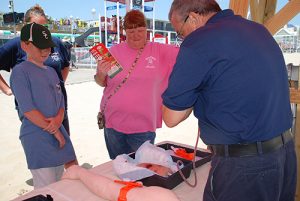
OCEAN CITY – A national security initiative made its way to the Ocean City beach this week to teach people bleeding control techniques.
As part of the Maryland State Firemen’s Association Convention this week, advanced life support (ALS) instructors with the Maryland Fire and Rescue Institute (MFRI) offered a “Stop the Bleed” demonstration Monday to those passing by on the beach and Boardwalk.
Jennifer Williams, public relations specialist with MFRI, said the one-on-one demonstration employs the use of props, fake blood and bleeding control techniques to teach members of the public basic lifesaving skills.
“If people know how to do this they can really save someone’s life,” she said. “You can bleed out in a matter of five minutes and that is much faster than help is going to get to you in a lot of situations, so we are teaching people how to be the help before the help arrives.”
The Stop the Bleed campaign teaches bystanders of terrorist-related activity, mass-shooting incidents, stabbings and other deadly situations to treat bleeding wounds before first responders get to the scene.
“This is actually a Homeland Security initiative,” she said. “Kind of like how CPR is taught to anybody … this is essentially the same thing.”
Williams said MFRI instructors recently began Stop the Bleed demonstrations, and have visited areas around the state to teach individuals, both young and old, bleeding control skills.
Dan Hughes, an ALS instructor with MFRI and retired Prince George’s County captain, said the demonstrations are currently done in conjunction with classes and events. He said instructors most recently had 600 individuals visit the Stop the Bleed demonstration booth at University of Maryland’s Maryland Day.
With kits lining the table, those on the beach and Boardwalk Monday also had the opportunity to learn and practice bleeding control techniques using artificial wounds, tourniquets and dressings.
“We have gunshots, knife wounds and bigger slashes, all designed to mimic either venous or arterial bleeding,” he said.
Hughes explained that in terrorist-related and large-scale incidents, like the Boston Marathon bombings, for example, 60-80 percent of victims are brought to the hospital by civilians, not ambulances, adding that bystanders play a vital role in saving a person’s life.
Hughes said some counties in Maryland have already placed bleeding control kits in high traffic areas and added that he expects other locations, including the Boardwalk, to follow suit in coming years.
“It’s for any place where there is a high accumulation of people,” he said, “or has the potential for it.”
Hughes estimates that supplies in the bleeding control kits can treat up to 15 people. He added that MFRI’s goal is to promote lifesaving skills and bleeding control kits.
“By the end of this year or next year, most regular BLS (basic life support) and ALS ambulances will be carrying extra kits so that they can do the same thing,” he said.
Williams said ALS instructors with MFRI will also spend a part of the convention training firefighters and EMS personnel how to use tourniquets and dressings found in the kits.
“We want to equip the public to be able to help themselves and help others before we can get there,” she said. “In this kind of scenario, they can actually end up being the first responder.”

